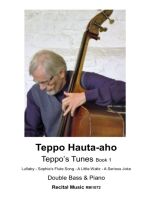Bass Quartets Book 3

Product code:
£10.00
Description
Bass Quartets Book 3 is a collection of six exciting and accessible transcriptions from the 16th-20th century which lend themselves beautifully to the bass quartet medium.
There are a few musical and technical challenges, alongside opportunities to play wonderfully inspiring music in concert or at home with friends. Bowings and dynamics can easily be adapted or amended to add further variety and interest to each.
All the pieces have been successfully performed at Bass-Fest and other workshops and concerts, often played by massed forces.
The editions include a score and four solo parts.
1. Rachel MacAndrew – Celtic Lament
Originally for piano, this piece amply demonstrates the lyrical and sonorous qualities of the double bass quartet and is an atmospheric and evocative miniature with opportunities for soulful and sonorous solo and chordal playing. There is no documentation about Rachel MacAndrew and this may be the pseudonym for another composer, but who knows?
2. Giuseppe Verdi (1813-1901) – Otello Solo
Arranged in 2008 and playable by bass quartet or larger forces, this is an ideal opportunity to study the famous double bass solo from one of Verdi’s greatest operas within the context of the orchestral accompaniment. Successful in performance, there are challenges for each performer and the melodic material is shared equally between the four parts. Great scope for creating a wonderfully sinister and brooding atmosphere with the generally low and subdued colours of the orchestral double bass.
“David Heyes, co-founder of Recital Music and a much sought-after double bass soloist and teacher, did a wonderful job with his arrangement of Verdi’s beloved double bass solo from the fourth act of Otello. It is perfect for students who are getting to know the solo for the first time. The arrangement includes notes describing what is taking place in the opera as the music is being played. Additionally, the orchestral introduction and interludes are arranged for the quartet to play. This not only helps the students gain a better understanding of the musical setting of the solo but also makes the quartet a more complete arrangement for performance. A piano accompaniment is also included for solo bass…perfect for aspiring bassists.”
[Micah Howard / Bass World – ISB]
3. Pizzicato Polka – Johann Strauss (1825-1899) & Josef Strauss (1827-70)
The Pizzicato Polka was first performed on 12 June 1869 and was played no less than nine times that evening. It was the first all-pizzicato work, other notable examples being by Léo Delibes (Pizzicato Polka from ‘Sylvia’) and Benjamin Britten (Playful Pizzicato from ‘Simple Symphony’), and has captivated audiences for over 150 years.
Who better than to play a pizzicato polka than the undisputed kings of pizzicato – the basses! Arranged by David Heyes for a concert series in Mallorca, it can be performed by single players or larger forces and is also available in an edition for double bass trio.
“This is a fine arrangement of the old Viennese chestnut…this particular edition for has the top part going up to thumb position, and the other players firmly within the orchestral tessitura. The parts are nicely spaced, so you should be able to achieve a well-balanced and effective performance. The original Pizzicato Polka for strings received no less than eight encores at its world premiere in 1869, so plucky trio bassists should take care of their pizzicato fingers. Bravo!” [ESTA News & Views]
4. Edward Elgar (1857-1934) – Elegy Op.58
This poignant and evocative Elegy, originally for string orchestra, was composed in 1909, between writing the two symphonies and at the height of Elgar’s compositional powers. Transposed a semitone lower than the original – now in D major – this is a solemn, lyrical and atmospheric work which transcribes well for double bass quartet. There are few challenges and it exploits the wide orchestral range of the double bass, and would be ideal for any adventurous quartet looking for something a little more serious.
5. Scott Joplin (1868-1917) – Original Rags
Written in the same year as the Maple Leaf Rag, and published in 1899, this was Joplin’s first work to appear in print. It has great rhythmic variety and ingenuity and the melodic interest is equally distributed between the players. There is a ‘hoe-down’ feel throughout making this a lively, upbeat and fun addition to the transcription repertoire. There are a few simple phrases played in harmonics, adding height and clarity, and there are effective and accessible musical and technical challenges for each player. Original Rags would be ideal for any audience or occasion.
6. Thomas Tallis (1505-1585) – Out from the Deep
Originally for SATB choir and set to the text of Psalm 130, this part-song is attributed to Thomas Tallis but could have been composed by William Parsons. Primarily chordal, with effective part writing, this has a gentle beauty and transcribes well for the bass quartet or massed bass orchestra medium.
Description
Bass Quartets Book 3 is a collection of six exciting and accessible transcriptions from the 16th-20th century which lend themselves beautifully to the bass quartet medium.
There are a few musical and technical challenges, alongside opportunities to play wonderfully inspiring music in concert or at home with friends. Bowings and dynamics can easily be adapted or amended to add further variety and interest to each.
All the pieces have been successfully performed at Bass-Fest and other workshops and concerts, often played by massed forces.
The editions include a score and four solo parts.
1. Rachel MacAndrew – Celtic Lament
Originally for piano, this piece amply demonstrates the lyrical and sonorous qualities of the double bass quartet and is an atmospheric and evocative miniature with opportunities for soulful and sonorous solo and chordal playing. There is no documentation about Rachel MacAndrew and this may be the pseudonym for another composer, but who knows?
2. Giuseppe Verdi (1813-1901) – Otello Solo
Arranged in 2008 and playable by bass quartet or larger forces, this is an ideal opportunity to study the famous double bass solo from one of Verdi’s greatest operas within the context of the orchestral accompaniment. Successful in performance, there are challenges for each performer and the melodic material is shared equally between the four parts. Great scope for creating a wonderfully sinister and brooding atmosphere with the generally low and subdued colours of the orchestral double bass.
“David Heyes, co-founder of Recital Music and a much sought-after double bass soloist and teacher, did a wonderful job with his arrangement of Verdi’s beloved double bass solo from the fourth act of Otello. It is perfect for students who are getting to know the solo for the first time. The arrangement includes notes describing what is taking place in the opera as the music is being played. Additionally, the orchestral introduction and interludes are arranged for the quartet to play. This not only helps the students gain a better understanding of the musical setting of the solo but also makes the quartet a more complete arrangement for performance. A piano accompaniment is also included for solo bass…perfect for aspiring bassists.”
[Micah Howard / Bass World – ISB]
3. Pizzicato Polka – Johann Strauss (1825-1899) & Josef Strauss (1827-70)
The Pizzicato Polka was first performed on 12 June 1869 and was played no less than nine times that evening. It was the first all-pizzicato work, other notable examples being by Léo Delibes (Pizzicato Polka from ‘Sylvia’) and Benjamin Britten (Playful Pizzicato from ‘Simple Symphony’), and has captivated audiences for over 150 years.
Who better than to play a pizzicato polka than the undisputed kings of pizzicato – the basses! Arranged by David Heyes for a concert series in Mallorca, it can be performed by single players or larger forces and is also available in an edition for double bass trio.
“This is a fine arrangement of the old Viennese chestnut…this particular edition for has the top part going up to thumb position, and the other players firmly within the orchestral tessitura. The parts are nicely spaced, so you should be able to achieve a well-balanced and effective performance. The original Pizzicato Polka for strings received no less than eight encores at its world premiere in 1869, so plucky trio bassists should take care of their pizzicato fingers. Bravo!” [ESTA News & Views]
4. Edward Elgar (1857-1934) – Elegy Op.58
This poignant and evocative Elegy, originally for string orchestra, was composed in 1909, between writing the two symphonies and at the height of Elgar’s compositional powers. Transposed a semitone lower than the original – now in D major – this is a solemn, lyrical and atmospheric work which transcribes well for double bass quartet. There are few challenges and it exploits the wide orchestral range of the double bass, and would be ideal for any adventurous quartet looking for something a little more serious.
5. Scott Joplin (1868-1917) – Original Rags
Written in the same year as the Maple Leaf Rag, and published in 1899, this was Joplin’s first work to appear in print. It has great rhythmic variety and ingenuity and the melodic interest is equally distributed between the players. There is a ‘hoe-down’ feel throughout making this a lively, upbeat and fun addition to the transcription repertoire. There are a few simple phrases played in harmonics, adding height and clarity, and there are effective and accessible musical and technical challenges for each player. Original Rags would be ideal for any audience or occasion.
6. Thomas Tallis (1505-1585) – Out from the Deep
Originally for SATB choir and set to the text of Psalm 130, this part-song is attributed to Thomas Tallis but could have been composed by William Parsons. Primarily chordal, with effective part writing, this has a gentle beauty and transcribes well for the bass quartet or massed bass orchestra medium.



